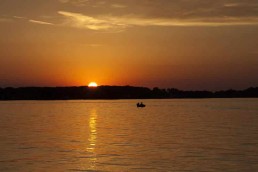Mark Brumbaugh and Open-water Trolling Techniques
SHARE THIS POST
I’m one of those guys who can listen for hours to fishing stories and advice; it doesn’t matter who’s telling the tale or offering the tips. Young or old, veteran angler or newbie, saltwater or freshwater, I will lend an ear.
But with me it’s more than just the sense of “hearing” that comes into play when I hear these angling adventures. Sometimes, I can close my eyes and visualize a 9-pound walleye coming up through the hole or the tap-tap and violent explosion of a brown trout or bass when it finally realizes something is “not right.” With sensations like these, it’s no wonder I get so excited out on the water. It doesn’t get old or become blasé.
Maybe that’s why I really do enjoy attending fishing seminars. There are dozens of respected pro anglers and charter captains, and salty, seasoned veterans of who speak. Obviously I can’t listen to them all, but those I do hear get my respect.
I recently had the chance to be in the audience for pro walleye angler Mark Brumbaugh’s presentation on open-water trolling. He opened his seminar with one question: “What do walleye do?”
He did receive a myriad of responses, but Brumbaugh simplified the answer: “Two things: They spawn and they eat.”
A short answer, yet in my mind maybe he was hinting that we often put too much thought into the process of fishing and not enough fun into it.
Brumbaugh proceeded to give an overall assessment of trolling during spring and summer.
In the spring, he said, “When the water is hovering around the mid-30-degree range, use crankbaits. When the water temperatures rise to 50 degrees, I begin using Rapalas, ‘crawler harnesses, spinnerbaits and Husky Jerks. However, don’t troll too deep.”
He also said top trolling speeds in these cooler waters should be 1 to 1.5 mph.
“It’s an ideal speed at this time of year,” Brumbaugh said. “Use a softer rod when trolling,” he said for summer, “like a 7- to 8 1/2-foot telescoping rod.”
He says a line-counting reel will be very useful too.
Are you enjoying this post?
You can be among the first to get the latest info on where to go, what to use and how to use it!
“With the line counter, you will have an idea of how far out the line was when the fish was hooked. Remember to spool those reels full.”
He added anglers should use spinnerbaits during these months because they work exceptionally well with planer boards.
Brumbaugh took more questions from the crowd and was willing to answer them all. Most revolved around the nuances of trolling, including lines, lure selection and scent. These were followed with additional helpful hints to increase catch rates.
There is a reason why planer boards can be successful. This is partly due to the agitation stirred up by trolling. As the prop rotates, its “wash” is similar to that of a washing machine throwing material to both sides. Thus, the planer boards set outside of the wash are very effective when traveling over newly-minted food sources coming out of the muck or weeds where walleyes will be waiting to begin foraging. Yes, they will be skittish as the noise and the sudden churned up waters pass by, but they won’t travel far because dinner is waiting.
“This is when the use of crankbaits like the Husky Jerk can be used to simulate the scattering of bait fish,” Brumbaugh said.
Even without planer boards, ambushing walleyes in prop wash can reap benefits—a time when a slower-moving boat passes by when you’re drift fishing. You wave to the occupants, but your focus should now really be on the wake trail left by their engine. Its prop wash has stirred up the bottom and potential food sources are now floating or struggling. This is the time to cast into the dissipating vortex with a jig or to experiment with a topwater lure. Boat traffic causes surges for baitfish and moving water entices walleyes.
“This is an ideal setting for the use of ‘crawler harnesses,” he said. “Use a small snap swivel attached to the line for more realistic action and add a piece of nightcrawler to the front hook (1 to 1 1/2 inches at most) for scent.”
He says there is never an absolute must in fishing.
“Finesse helps—the more finesse you use equates to more success. Use braided line on inland lakes and monofilament on bigger lakes. Also, if your crankbait isn’t working well while trolling (maybe moving to the right too much) bend the eye to the left and vice versa.”
Brumbaugh also admitted his favorite time to fish is when the lake is like a sheet of glass and he can create action with the bait attached to planer boards easier by zigzagging them when there is choppy water.
By this time, I am once again in a visual state where I can see the flag come up on my own planer board. The last, slow veering of my boat’s course triggers an attack and a nice walleye is ready to reel in. I get pumped when listening to stories about fishing and how to get them in a boat.
MWO
SHARE THIS POST
Did you enjoy this post?
You can be among the first to get the latest info on where to go, what to use and how to use it!
Rick Fowler
Rick Fowler has had his articles published in MidWest Outdoors for the past 26 years. Growing up in Northern Michigan whetted his appetite for fishing and hunting. It was further fueled by his grandfathers’ experiences, both avid outdoorsmen. Fowler writes about bird hunting and angling adventures in the Upper and Northern Lower Peninsulas of Michigan.



[…] https://midwestoutdoors.com/fishing/mark-brumbaugh-and-open-water-trolling-techniques/ – Mark Brumbaugh and Open-water Trolling Techniques – MidWest Outdoors […]